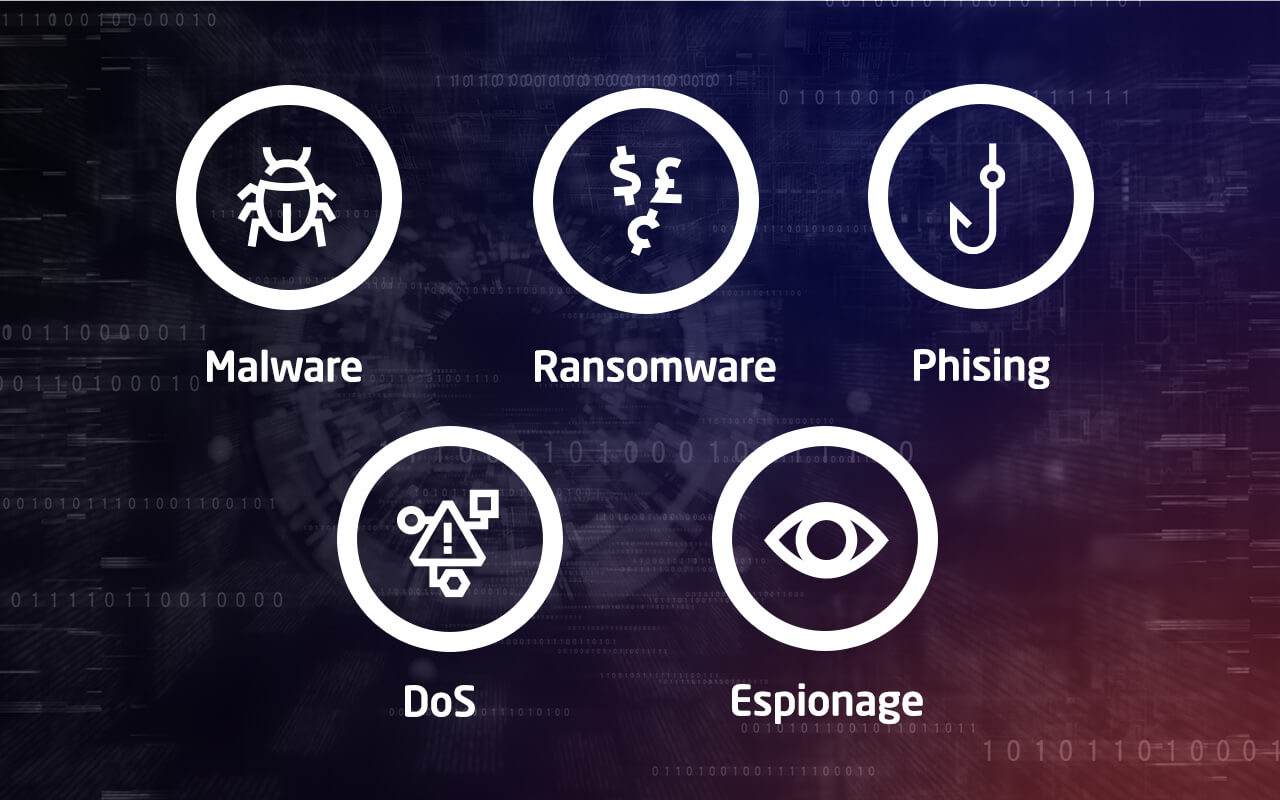Hacking definition: what is cyber hacking?
Cyber hacking, also known as cyber attacking, is the practice of intentionally exploiting weaknesses in an organization's computer systems. Cyber hacking can be used for purposes such as compromising or stealing data, disrupting communication or procedures, or to satisfy other harmful objectives.

5 Common cyber hacking techniques
Malware
Malware, short for malicious software, is a type of software that is specifically designed to steal information, disrupt operations, and/or damage the system of its victim. Once a victim activates malware, it will execute sequences of code that are designed to manipulate systems on the victim's computer.
Denial of Service
Denial of Service (DoS) attacks aim to shut down, damage, or otherwise inhibit certain essential functions of the victim's computer.
Ransomware
Ransomware is a type of malware that often encrypts its target's data and/or suspends essential operations temporarily with the promise to restore access after receiving a ransom payment.
Espionage
Sometimes cyber hackers gain access to networks in order to monitor their targets without noticeably damaging or stealing information. It is possible for cyber hackers to gain access to a user's camera, audio devices, and even password-protected applications without their victims ever knowing.
Phishing
A phishing attack is a method cyber hackers use to deploy malware and ransomware and/or gain access to login credentials or confidential information. Cyber hackers will create an imposter email, webpage, or social media profile as bait to lure victims into clicking on links that actually download malware.
3 Tips to prevent your organization from getting hacked
The best way to prevent your organization from getting hacked is to partner with a cybersecurity service provider like Mimecast. Mimecast helps businesses implement sophisticated but easy-to-use cybersecurity systems that effectively mitigate the risk of being hacked.
1. Implement secure email communication
From end-to-end email encryption, to email authentication policies, it’s important to secure the email messages sent and received by your organization as well as protecting your organization from cyber hackers who may be trying to send you malware.
2. Secure your data backups
Cyber hackers have a hard time getting into cloud-based storage systems, which also happen to be a convenient method for organizations to use for archiving their data. In the event of a system failure or data breach, having a data backup can be the difference between a close call and a multimillion-dollar ransomware attack.
3. Empower employees
The overwhelming majority of successful cyber hacks stem from human error, whether from setting a weak password or falling prey to a phishing attack.
Many people don't know what they don't know about cybersecurity, but Mimecast offers Security Awareness Training that can catch everyone in your organization up to speed. Just the same as everyone needs to do their part to keep physical offices safe from thieving by locking doors and filing cabinets, everyone should learn how to do their part to keep virtual spaces safe from cyber hackers.
Defend against cyber hacking with a cyber resilient strategy
Despite your investment in the best cyber security solutions, your organization will likely fall victim to cyber hacking at some point in the future. It's simply too difficult to defend against cyber threats and vulnerabilities that are constantly evolving and growing in number. That's why you'll want to consider the latest paradigm in cyber defense: addressing cyber hacking with a strategy for cyber resilience.
Cyber resilience includes cyber security solutions to prevent cyber hacking as well as tools to mitigate the impact of a successful attack. It's about ensuring continuity during an attack, and about preventing the kind of damage that can have disastrous repercussions for your business and the bottom line.
Most cyber hacking today involves some kind of email-borne threat. Ransomware, spear-phishing and impersonation fraud are only the latest in a cyber risk landscape that is continually becoming more sophisticated. That's why any resilience strategy to combat cyber hacking must include tools to protect email, simplify email backup and recovery, and ensure continuous access to email data during and after an attack.
That's where Mimecast can help.
Prevent cyber hacking with Mimecast
Mimecast offers a suite of cloud-based services for email risk management that can power a resilient strategy for combating cyber hacking. Our fully integrated, SaaS-based solutions enable you to handle all aspects of email management from a single pane of glass. Our comprehensive services mean you can avoid deploying disjointed cyber security software and hardware solutions from multiple vendors. Our powerful cloud platform architecture enables massive scalability, and our vibrant community of member organizations – more than 40,000 and growing – provides an incredible knowledge base and proof of the success of our services for defending against cyber hacking by email.
Integrated solutions to combat cyber hacking
Our solutions empower you to both prevent cyber hacking and to reduce the impact and damage of any successful attack. Our services provide:
- Advanced security. Our security services are designed to prevent cyber hacking by employing multi-layered detection engines and threat intelligence to protect email data and employees from viruses, malware, spam, data leaks and advanced threats like ransomware.
- End-user awareness. We help train employees to better understand and implement best practices for avoiding and spotting potential cyber hacking attacks.
- Business continuity. When your primary email servers go down due to a cyber attack, natural disaster or mechanical failure, our continuity services allow your users to continue to send and receive email without disruption.
- Multipurpose archiving. Our archiving tools help you better protect email, file and IM conversations. With data that is always protected, replicated and available, users have constant access to data, and administrators can manage backup and recovery, compliance and e-discovery more easily.
Learn more about stopping cyber hacking with help from Mimecast.
Cybersecurity hacking FAQs
What is ethical hacking?
Ethical hacking is a method of testing your cybersecurity where someone is authorized to make an attempt to gain unauthorized access to your computer, system, or data. This practice helps you protect against real cyber hacking attempts by giving you a clear understanding of where your weaknesses are, and how to bolster them.Are all types of businesses vulnerable to hacking?
The most vulnerable businesses are those who have perceivably high revenue and perceivably low security. Growing organizations especially need to ensure that as their value increases, so too does their level of security.
Notwithstanding, cyber hackers can target any business, and the less cyber security a business has, the more vulnerable it will be to hacking. While cyber security software and services do effectively block hacking attempts, they can also provide great value in that they deter hackers from even trying.How should hacking be reported
In most countries, hacking is a crime that is enforced at the national level. In the United States, for example, hacking attempts--successful or not--should be reported to the FBI. Be sure to take down as many details as possible, including name(s), email address (es), ransom amount(s), and emails or webpages that contained the malware. Always be sure to document as much of the hacking incident as you can in order to provide law enforcement with as clear a picture as possible.



